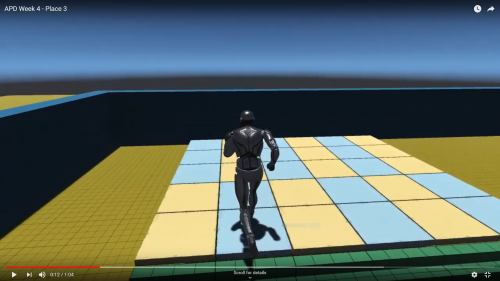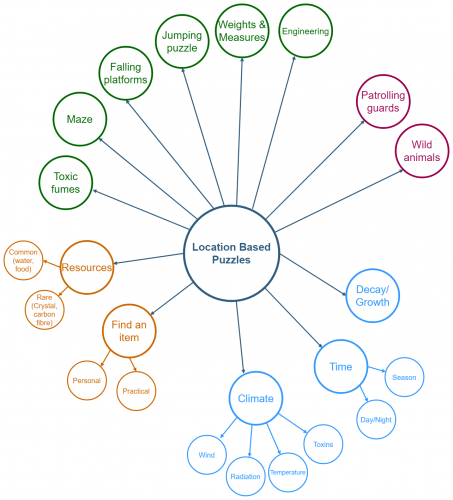Videos
Version 1: https://youtu.be/cmljSZABzYY
Version 2: https://youtu.be/5k0qn5H5czs
Version 3: https://youtu.be/UFXmYZ9q7oI
Theme
Space vs place
-
Game environments should be more than just a space in which gameplay occurs
-
A game environment promotes player engagement with the play space when the game environment itself responds to player interaction
-
I want to develop some fun environmental challenges which include physical puzzles and dynamic interactions with cycles in game world simulation, day/night or wind direction for example
Key Questions
- What are some environmental & situational puzzle mechanics I could experiment with?
- What are some environmental cycles I could try to incorporate into location based puzzles?
- How can I attempt to implement both in a prototype and see how they feel together?
Context
The Long Dark (2017) - cycles, aurora, day/night
- This survival game uses weather, climate, day/night and the presence of atmospheric aurora to change the conditions of the player’s environment and present challenges for the player character’s survival depending on different situations.
- There are a number of other factors such as wildlife and the basic needs of the player character but I am particularly inspired by one environmental puzzle in which the player must access an underground facility which is locked behind an electronically controlled door and can only be accessed whilst the atmospheric aurora is active, using a keycard which is hidden elsewhere in the game world.
- I’m interested in this relationship between puzzle factors in the game world which the player can control (finding the keycard) and cycles or fluctuations in game world factors which can be predicted but not controlled (the intermittent appearance of the aurora).
Rust (2018) - Jumping puzzles
- In this open world multiplayer game, there are locations on the map called ‘monuments’ which contain rare resources and one of the factors which make these locations challenging are a series of simple jumping puzzles which require players to navigate around a series of ledges, pipes, beams and other forms in order to reach these resources.
- These kinds of puzzles are a common central gameplay mechanic in other games like Super Mario Bros (1987), Tomb Raider (1996) and Uncharted (2007). In Rust however, the main gameplay mechanics are closer to those of first person shooters, survival and crafting/building games and the jumping puzzles provide a fun and interesting complimentary challenge in the game, whilst trying to avoid being shot by other groups of players competing for those same resources.
Method
- Create a prototype Unity project including a 3rd person perspective character controller from the asset store (Invector 3rd Person Controller Free) which can move around the scene, run and jump
- Build a series of ‘building block’ objects with which to begin constructing location based puzzles
- Build and script behaviour for a ‘falling platform’ which changes colour when the player comes into contact with it and then falls shortly after, giving the player a moment to get across it
- Create a day/night cycle with an adjustable time scale
- Create 2 variations of ‘falling platforms’, one which falls during the day and one which falls at night
- Build a jumping puzzle using puzzle pieces
Reflection
- Coding takes a lot of time to figure out, especially when you’re learning how to do everything yourself. This project took me about 2 full days of work to complete.
- Platforms were fiddly but once they were working they were easy to build functionality on top of.
- My use of character controller assets and ProBuilder, ProGrids packages helped immensely in setting up prototype
- Unity’s various rendering pipelines handle skybox rendering differently so I had to sift through tutorials
References and Resources
- Invector 3rd Person Controller Free https://assetstore.unity.com/packages/tools/utilities/third-person-controller-basic-locomotion-free-82048
- The Long Dark (2017) https://www.thelongdark.com/, https://en.wikipedia.org/wiki/The_Long_Dark
- Rust (2018) https://rust.facepunch.com/, https://en.wikipedia.org/wiki/Rust_(video_game)
- Super Mario Brothers (1987) https://en.wikipedia.org/wiki/Super_Mario_Bros.
- Tomb Raider (1997) https://en.wikipedia.org/wiki/Tomb_Raider
- Uncharted (2007) https://en.wikipedia.org/wiki/Uncharted
About This Work
By Nick Margerison
Email Nick Margerison
Published On: 01/04/2020

